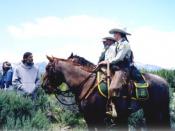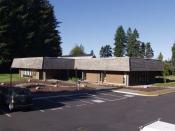Background Information
Late in the year 2000, the Clinton Administration directly issued several new rules to affect the National Forest System (NFS). The most controversial of these rules pertains to 'roadless areas' of the NFS. Commonly known as the Roadless Areas Initiative, it restricts road building and development in approximately 58.5 million acres of inventoried United States Forest Service (USFS) roadless areas, roughly one third of all NFS lands. Before the Roadless Rule was issued, the Forest Service held a public comment period where 1.6 million comments were received. The final rule, signed on January 5, 2001, prohibits new road construction and reconstruction on all 58.5 million acres with a few exceptions, such as protecting public safety. On May 10, 2001 a preliminary injunction was granted that effectively halted the rule .
The Roadless Area Initiative has inspired heated debate between environmental groups, business, and other interests, and some have taken political or legal action.
Most of these debates revolve around whether or not all points of view were adequately represented during the comment period, how the rule may or may not effect jobs, and if the rule is appropriate forest management.
Interest Groups That Are Playing A Role
There is a wide range of interest groups that support the initiative that are playing a role in this issue; so wide that it is impossible to address them all. I have chosen to discuss the Heritage Forest Campaign because it is affiliated with so many other groups. The Heritage Forests Campaign is an alliance of conservationists, wildlife advocates, educators and others who lobby for National Forest protection. Heritage Forests Campaign's partners include Alaska Rainforest Coalition, American Hiking Society, Earthjustice Legal Defense Fund, National Environmental Trust, National Audubon Society, Natural Resources Defense Council, US PIRG, and The Wilderness Society .
As far as environmental groups go, the Heritage Forests Campaign is basically mainstream. Most of their partner groups are well established and have members across the nation, thus providing more financial and other resources than many groups. Although much of their activity is in letter writing and the like, they have been associated with many lawsuits and other more 'corporate' tactics.
The Heritage Forest Campaign's goal is to expedite the implementation of the initiative in its original incarnation. They believe that the initiative has gone through the proper legal channels and that the Forest Service has adequately gathered and assessed public opinion on the issue. They also believe that the rule allows for proper forest management. Their main ways to influence the issue is by lobbying lawmakers and by filing lawsuits. They also may indirectly influence the issue by urging citizens unaffiliated with their group to tell political leaders how they feel about the issue .
Opposition to the initiative is less widespread, but still significant. The Boise Cascade Corporation was the first to initiate litigation against the initiative and likely has the most financial and political power of those who oppose it. Boise Cascade is a large timber and paper company that holds more than two million acres of timberland, mostly in the Northwest.
Boise Cascade's goal is to prevent implementation of the Roadless Rule as it is currently written. They want it to either be abandoned altogether or to have the Forest Service perform another public hearing to amend it. Boise Cascade believes that the Forest Service did not get opinions from a wide enough range of perspectives, the rule violates previously existing laws, and it is bad forest management. This company can influence the issue in many ways through financial means. They can influence politicians whose campaigns' they donate to, file lawsuits on their own or with others, or possibly urge their workers, business partners, and stockholders to lobby against the initiative .
Resources And Strategies That The Groups Are Using
The Heritage Forests Campaign has launched a public appeal for a massive campaign of letters, emails and faxes to President Bush, urging him to expedite the implementation of the issue. They send calls for action via mail and email to their members, and also to members of other environmental organizations by sharing or selling member lists . On February 6, 2001, lawyers from two of their affiliates, Earthjustice and the Natural Resources Defense Council (NRDC), filed court papers opposing the industry and state lawsuits that seek to overturn the U.S. Forest Service rule. Although the Heritage Campaign is not directly named in the lawsuit, many of their partners are and they have vowed to fully support the suit with human and financial resources .
The strategy of Boise Cascade and other groups opposed to the initiative has been to find legally questionable aspects of the rule and file lawsuits to prevent the initiative from being implemented. Currently more than 40 separate individuals and organizations are plaintiffs in eight separate lawsuits that dispute the legality of the initiative. The litigants include Boise Cascade and other businesses, a number of western states and counties, recreational clubs, and professional timber and lumber associations . Many of these clubs and associations are not generally able to fund lawsuits. However, by aligning themselves with businesses and states that do have adequate financial resources, they are able to join the suit as co-plaintiffs.
Where In The Process They Are Focusing Their Efforts
Until recently, the Heritage Campaign has focused its efforts on lobbying, possibly because is difficult for them to acquire sufficient funding to file lawsuits and such. However, they have recently decided to associate themselves with litigation. I think they are now focusing on this because so much lobbying has already occurred that it may be losing its effectiveness. Also, they are trying to directly respond to the lawsuits by Boise Cascade and others and not be left behind.
To an extent, Boise Cascade has also participated in lobbying but somewhat indirectly, as there are some political campaigns that they donate to. However, their efforts have mainly focused on litigation, most likely because they have the legal and financial resources to do so. Going to court can sometimes (but not always) garner faster results than going to other places in the policy process; in fact, Boise Cascade was part of the group that won the injunction against the rule earlier in the year.
Representation of groups at stake
The Heritage Campaign seems to be reflecting mainstream environmental interests well due to its firm but not overly aggressive approach. Boise Cascade is likely representing the view of those involved in the timber industry. Although these are the two kinds of groups with the biggest stake in the issue, it leaves out a lot of the general public and the scientific community. Both sides claim to know what it best for the general public, but it does not appear that they have made a serious effort to ask them their opinion. They also both claim to have science on their side, but the science is conflicting. In all likelihood, there isn't a large enough contingency of scientists who agree on this issue to form substantial interest group.
The way these groups are participating is, in some ways, in line with the ideals of democracy and public participation. Democracy is based on the ideal that each person has an equal voice, and through letter writing campaigns and the like, that ideal can be achieved. However, with mergers of groups and large lawsuits on both sides, individual voices are often lost. Yet for the public's voice to really be heard it generally requires large amounts of people with financial resources behind them.
Recommendation to the Heritage Forests Campaign
The Heritage Forests Campaign could increase its effectiveness in the policy
process by being more aggressive with litigation. In this case, they haven't specifically introduced it themselves, but they could have aligned with their partner groups and introduced it earlier in the process. By responding to Boise Cascade's suit after the fact, they are a step behind and put in a defensive position. It would have been more effective for them to respond while the rule was being delayed earlier in the year. Although the Heritage Forest Campaign has limited financial resources, their money would be wisely spent initiating legislation and establishing standing with their partners. Even with a verdict against them, or if they fail to make it to court at all, this will show that their group is serious enough about the issue to go through this process.
Works Cited
66 FR 35918-35920, July 10, 2001. National Forest System Land and Resource Management Planning; Special Areas; Roadless Area Conservation.
Congressional Research Service Reports RL30647: The National Forest System Roadless Areas Initiative. National Library for the Environment. http://www.cnie.org/nle/crsreports/forests/for-33.cfm. 27 November 2001.
Forests In Limbo. Heritage Forests Campaign.
http://www.ourforests.org/ 29 November 2001.
National Forests Roadless Initiative. Boise Cascade Corporation http://www.bc.com:8009/~bcdocs/enviro/eproads.html 28 November 2001.
Roadless Area Initiative. Southern Environmental Law Center. http://www.selcga.org/act_roadless_ini.shtml 29 November 2001.


